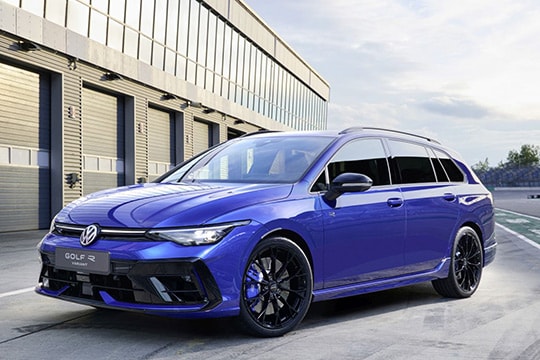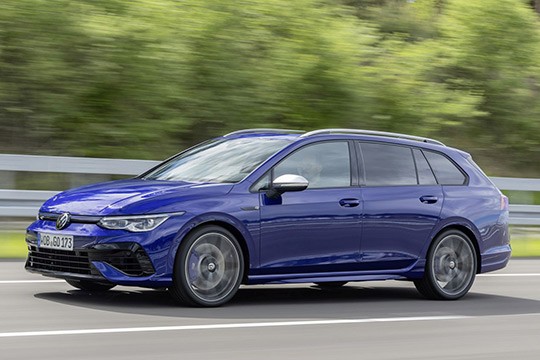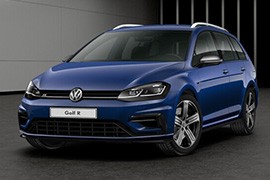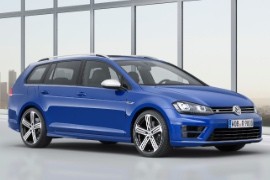VOLKSWAGEN Golf R Variant Models/Series Timeline, Specifications & Photos
First production year: 2015
Engines: Gasoline
Body style: Wagon (station wagon, estate, combi, touring)
Volkswagen refreshed the entire eighth generation of the Golf lineup in the summer of 2024, and besides other regular versions, it also upgraded the R Variant, which was the hottest station wagon of the family.
When the German automaker introduced the first R-labeled model, the 2003 R32, it produced it as a three-door or five-door hatchback, the latter being built exclusively for European customers. Later on, Volkswagen understood that a V6-powered vehicle didn’t make too much sense for its customers, so it launched the 2006 Golf R powered by a turbocharged four-banger. The all-wheel-drive system and the dual-clutch gearbox were still part of the package. But those who grew up with these cars on their walls became parents, and a hot hatch didn’t make too much sense for a family. As a result, Volkswagen expanded the range and installed the same drivetrain under the skin of a station wagon, offering it as a Golf R Variant. It was the beginning of a new era, where three-door hot hatches were replaced by five-door hot wagons. The refreshed 2025 Volkswagen Golf R Variant had more ponies under the hood, better interiors, and not-so-subtle exterior enhancements.
At the front, the automaker installed standard LED headlights visually connected via a light stripe. Underneath it, on the main grille, the automaker placed the illuminated Volkswagen logo, which seemed like it connected the hood with the bumper. The latter sported an R-unique apron featuring a broad, shiny black grille split in three, where the middle part helped to cool the engine while the side scoops created the air curtains around the wheel wells to reduce drag.
From its profile, the 2025 Volkswagen Golf R Variant didn’t show its true nature. However, its lower ground clearance due to the standard adaptive suspension and the 18-inch standard alloy wheels could raise some questions. The automaker even offered a set of 19-inch forged alloys to complete the package. Besides that, there were no fancy side sills or flared wheel arches. But still, the wing above the tailgate and the massive diffuser on the lower part of the bumper could give some hints about the vehicle’s performance.
Inside, Volkswagen created a mix of a sporty ambiance with some luxurious touches and a healthy dose of practicality. The driver fronted a three-spoke steering wheel fitted with touch buttons and sported the R-logo on the lower spoke. Behind it, the automaker placed larger paddle shifters that allowed drivers to manually select the desired gears. The color display inside the instrument cluster was already something usual for the Golf, albeit the 13-inch touchscreen for the infotainment system, which integrated ChatGPT, was new. At the front, customers were hugged by high-bolstered sports seats with integrated headrests wrapped in fabric and microfiber upholstery, which were unique for the Golf R lineup. Between them, the car had a center console that housed the gear selector, a few buttons for various vehicle functions, and a pair of cup holders. In the back, the split-folding bench seat could expand the trunk space from 611 liters (21.6 cu-ft) to 1,642 liters (58 cu-ft).
Under its skin, the go-fast station wagon had a turbocharged two-liter gasoline engine producing 333 PS (328 hp), which was 13 PS (12 hp) up from the non-facelifted version of the Golf R Variant. Unlike its predecessor, the 2025 model year was available with a seven-speed automatic (dual-clutch) gearbox only since Volkswagen deleted the six-speed manual option from the entire R lineup.
While the Golf R was designed for those who enjoyed driving and didn't need a large trunk in the back, the Golf R Variant came as an important addition for those who needed a station wagon.
A family with kids needs a car with a big trunk where the bicycles, scooters, and other toddler-related items need to be stored. On the other hand, nobody said station wagons can't have powerful engines. And Volkswagen decided to give an important boost to its already known Golf Variant in the form of the R version.
The 2021 Golf R Variant shared most of its bodywork with the Golf R up to the B-pillar, but it featured different C-pillars and rear doors. An additional glass area covered the space between the C- and the D-pillar. The carmaker sacrificed some part of the trunk space for this Golf generation and raked-forward the tailgate for a sportier look. Volkswagen even installed a roof spoiler on the upper side of the rear windscreen. Under the bumper, the carmaker installed four oval exhausts, similar to those from the Golf R hatchback.
Lile its Golf R sibling, the R Variant featured a sporty interior with high-bolstered front seats. Its full-digital instrument cluster and the paddle-shifters behind the wheel were just a confirmation that it wasn't just a regular grocery-getter. But, since it was a station wagon, it offered a split-folding rear bench which provided between 611 liters (21.6 cu-ft) and 1,642 liters (58 cu-ft) of trunk space.
For the drivetrain, Volkswagen installed a turbocharged inline-four gasoline engine. It was paired to either a 6-speed manual or a 7-speed DSG (dual-clutch) automatic transmission. Power went to all corners via a newly developed all-wheel-drive system with torque vectoring.
The Volkswagen Golf GTI was the hot hatch segment's inventor, even though the original GTI only had 115 hp.
Fast-forward to 2017 and we find the Golf R Variant, a true sleeper in the compact-segment. While the first-ever Golf R had a naturally aspirated 3.2-liter V6 engine, the 2017 R has a 2.0-liter turbocharged gasoline unit with almost 300 hp under the hood. It was mated either with a 6-speed manual or a 7-speed DSG (dual-clutch).
From the outside, only the front bumper and the twin-dual exhaust could tell the difference compared to a regular model with options on it. The 19" light-alloy wheels were standard for the R. Other Golfs with the R-Design package didn't have them. The station wagon was more subtle than its hatchback brother, since it looked like a family vehicle used for weekend shopping at IKEA. The differences with other Golf versions continued inside, where nicely bolstered bucket seats were holding the front occupants while cornering.
The leather and fabric combination seats are nice to view as well, and the R-logo embodied on the seatback is visible. The dashboard has a TFT screen carried-over from Audi's Virtual Cockpit, and it was customizable. The speedometer and tachometer are accompanied by other various information, including the sat-nav system squeezed in the middle on the screen. Like any other decent station-wagon, it featured a split-folding rear seat seatback.
But what makes the Golf R more special is the mechanical layout. The 300 hp and the all-wheel-drive system made it a competitor for other rally-inspired cars, such as the Subaru STI, which was offered as a station-wagon as well.
For those who asked for enough room for a family and supercar performance, Volkswagen produced the Golf VII R Variant, a car that could smoke many other famous sportscars while carrying a fridge in the trunk.
Volkswagen introduced the R lineup in the Golf family in 2013, but the car's success determined the automaker to offer it also as a station wagon. Thus, owners could easily do school runs, shopping days, and track days.
When Volkswagen decided to go to another level with its famous hatchback, the Variant was considered to receive the same drivetrain as the rest of the Golf R range. And, just like its siblings, this version got an aggressive front fascia with a beefier front bumper that sported a trapezoidal lower grille and a pair of big, functional side scoops. From its profile, the Variant was identical to the five-door version up to the B-post. There were different rear doors and a third side window between the C- and the D-pillars. At the back, the slightly tilted forward tailgate sported a roof spoiler at the top. Finally, to further enhance the car's look, the automaker installed a quad exhaust system under the rear bumper, flanking a diffuser.
Inside, the high-bolstered front seats' backrests received the "R" badge embroidered in the upholstery. On the dashboard, the automaker installed an instrument cluster with two large dials for the speedometer and tachometer, flanking a small display between them and the smaller gauges for the fuel level and coolant temperature. In addition, the center stack sported the screen for the infotainment system. Behind the rear split-folding bench, the Golf R Variant offered a 605 liters (21.4 ft) trunk. With the rear seats folded, the storage area was increased to 1,620 liters (57.2 cu-ft).
Under the hood, Volkswagen installed a two-liter turbocharged gasoline engine that produced 300 PS (296 hp). It was paired with a six-speed automatic (dual-clutch) transmission that sent the power in all corners.
VOLKSWAGEN Golf VII R Variant 2.0L TSI 4MOTION 6AT AWD (300 HP)



